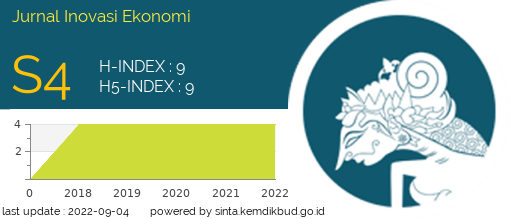Attitude and behavior on daily food purchasing decisions in the time of COVID-19: A case study of Indonesia consumers
DOI:
https://doi.org/10.22219/jiko.v5i02.11866Keywords:
Cashless, contactless, behavior, online, virus disease, attitudeAbstract
This investigation was carried out to exam the influence of attitudes towards COVID-19 with food on purchasing decisions of early adult consumers with a quantitative survey approach. The data relates to the attitude which includes that the virus is dangerous, difficult to cure and originates from China and purchasing decision behavior to fulfill daily food needs consists of being careful in choosing, paying attention to producers, care to the countries of origin, cashless payment usage, and paper money avoidance was collected with a four-scale style questionnaire distributed via Google form. Data obtained by the sample (n = 157) were selected using convenience methods and then analyzed by playing the Structural Equation Modeling, assisted by Smart-PLS. The result shows that attitude correlates with behavior in fulfilling daily foods. The attitudes towards the COVID-19 come from China that is dangerous, difficult to treat, contributes to cautious behavior, healthy behavior in meeting daily food needs, and purchasing payment usage. The consumer tends to the more careful in choosing, paying attention to care for the food producers, and where food comes from. Attitudes also have an impact on the preference of consumers to use E-money and paper money avoidance as an effort to avoid physical contact with the seller or supplier.
Downloads
References
Ajzen, I. (1991). The theory of planned behavior. Organizational Behavior and Human Decision Processes, 50(2), 179-211. doi:10.1016/0749-5978(91)90020-t
Ajzen, I. (1993). Attitude theory and the attitude-behavior relation.
Ajzen, I. (2015). Consumer attitudes and behavior: The theory of planned behavior applied to food consumption decisions. Rivista di Economia Agraria, LXX(2), 121-138. doi:10.13128/REA-18003
Ali, N., & Abdullah, M. A. (2012). The food consumption and eating behaviour of Malaysian urbanites: Issues and concerns. GEOGRAFIA OnlineTM Malaysia Journal of Society and Space, 8(6), 157 - 165.
Alon, T., Doepke, M., Olmstead-Rumsey, J., & Tertilt, M. (2020). The Impact of COVID-19 on Gender Equality.
Ayudya, A. C., & Wibowo, A. (2018). The Intention to Use E-Money using Theory of Planned Behavior and Locus of Control. Jurnal Keuangan dan Perbankan, 22(2), 335–349. doi:10.26905/jkdp.v22i2.1691
Bhurosy, T., & Jeewon, R. (2016). Changes in eating habits and food traditions of Indo-Mauritians. Indian Journal of Traditional Knowledge, 15(3), 355-362.
Fila, S. A., & Smith, C. (2006). Applying the Theory of Planned Behavior to healthy eating behaviors in urban Native American youth. Int J Behav Nutr Phys Act, 3, 11. doi:10.1186/1479-5868-3-11
Fraikue, F. B. (2016). Reasons For Eating Out And Socio-Demographic Characteristics Of Customers. Paper presented at the Proceedings of INCEDI 2016 Conference | August 29-31, 2016, Accra -Ghana 651.
Hackman, C. L., & Knowlden, A. P. (2014). Theory of reasoned action and theory of planned behavior-based dietary interventions in adolescents and young adults: a systematic review. Adolesc Health Med Ther, 5, 101-114. doi:10.2147/AHMT.S56207
Haven, A. (2015). Consumer Behavior and the Growth of the Fast Food Industry in a Small Emerging Country. International Journal of Advances in Management and Economics Available online at: www.managementjournal.info, 4 180-189.
Icek, A. (2012). The Theory of Planned Behavior. In Handbook of Theories of Social Psychology (Vol. Volume 1, pp. 438-459).
Meng, L., Hua, F., & Bian, Z. (2020). Coronavirus Disease 2019 (COVID-19): Emerging and Future Challenges for Dental and Oral Medicine. J Dent Res, 22034520914246. doi:10.1177/0022034520914246
N. Srividhya. (2014). “Eating Out Habit of Individuals – An Analytical Study” (With Special Reference to Puducherry City). International Journal of Business and Management Invention ISSN (Online): 2319 – 8028, ISSN (Print): 2319 – 801X www.ijbmi.org Volume 3 Issue 6ǁ June. 2014 ǁ PP.38-44.
Putra, D. M. (2016). The Influence On Factors In Attitudes Toward Acceptance Of The Information System Using Technology Acceptance Model (TAM) Case Study SPAN System In Indonesia. International Journal Of Scientific & Technology Research, 5(4), 5.
Rahmath, S., Hema, D., Nisar, H., & Abdullah, K. (2013). Combination of TAM and TPB in Internet Banking Adoption. International Journal of Computer Theory and Engineering, 146-150. doi:10.7763/ijcte.2013.V5.665
Symmank, C., Mai, R., Hoffmann, S., Stok, F. M., Renner, B., Lien, N., & Rohm, H. (2017). Predictors of food decision making: A systematic interdisciplinary mapping (SIM) review. Appetite, 110, 25-35. doi:10.1016/j.appet.2016.11.023
Vabø, M., & Hansen, H. (2014). The Relationship between Food Preferences and Food Choice: A Theoretical Discussion. International Journal of Business and Social Science, 5(7).
Widayat. (2016). Analisis Data Penelitian [Konsep Dan Aplikasi Pada Penelitian Kuantitatif] (Vol. 1). Malang: UMM Press.
Widayat. (2018). E-Consumer Behavior: The Roles of Attitudes, Risk Perception on Shopping Intention-Behavior. Advances in Economics, Business and Management Research, 57.









